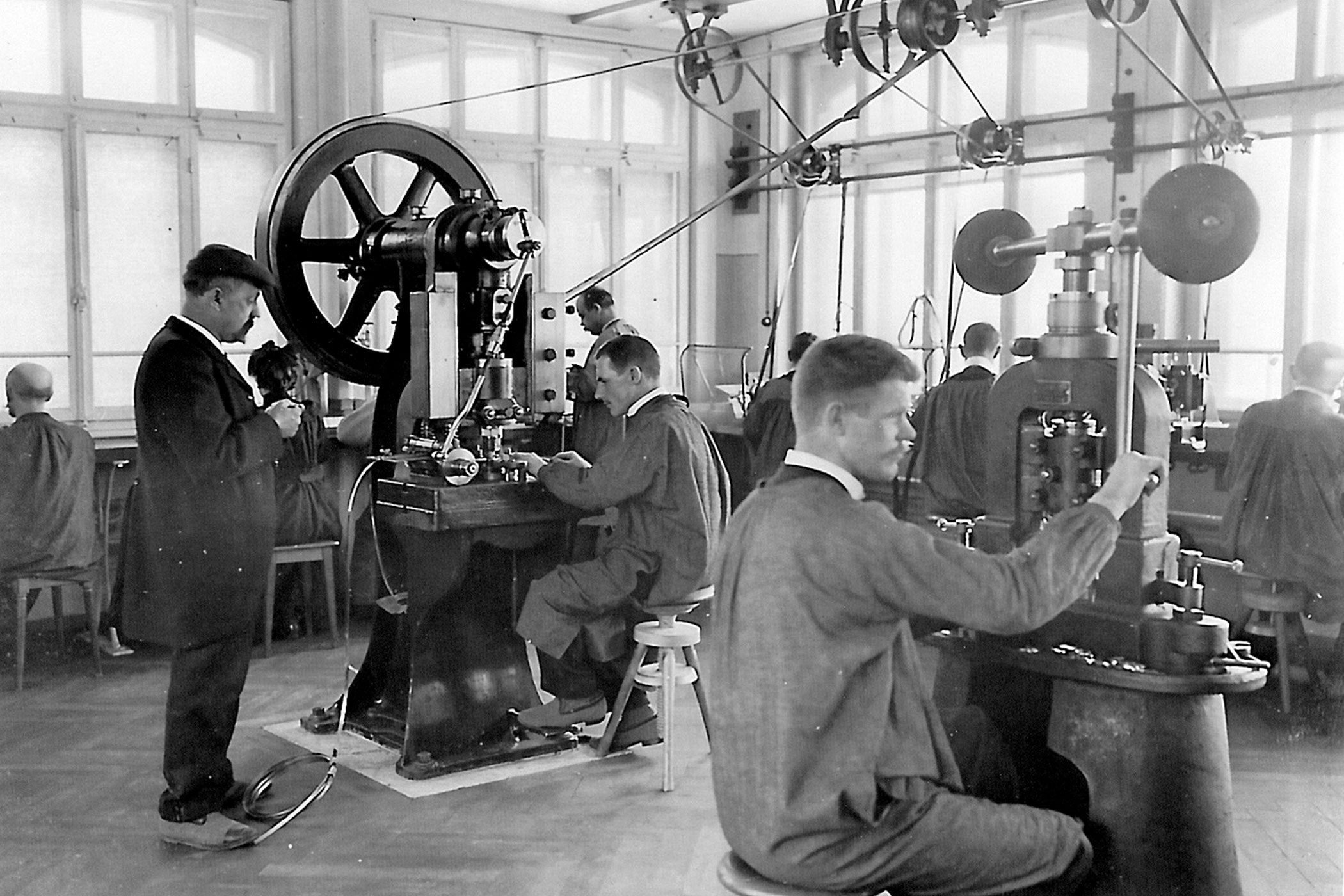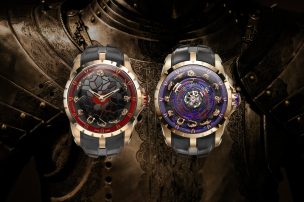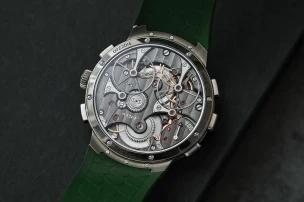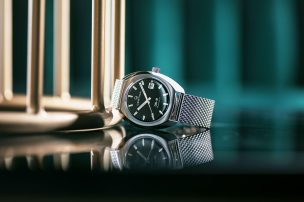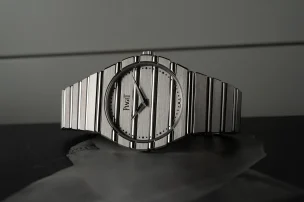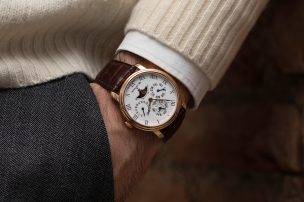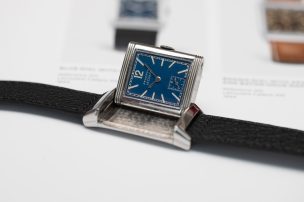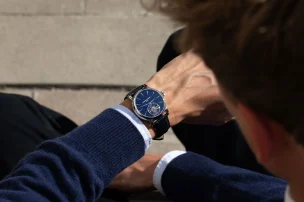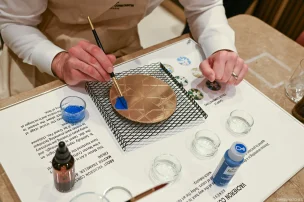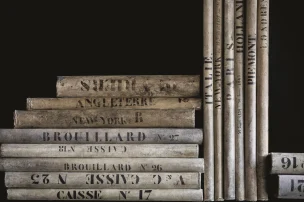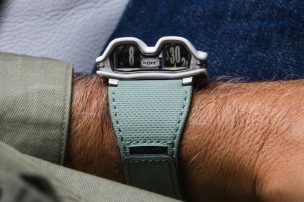

140 Years of Alpine Watch Tradition: A Conversation with Brand Manager Oliver van Lanschot Hubrecht on Alpina’s Anniversary
A veil of grey clouds covers the snow-clad Matterhorn, one of the icons of the Alps. The summit only makes a timid appearance on this day, but it creates a no less imposing backdrop for an anniversary celebration. With a view of the Matterhorn to accompany it, the Swiss watch brand Alpina is honouring its 140th anniversary. In doing so, Alpina not only looks back on its tradition-steeped past but with the two limited Alpiner Heritage Carrée Mechanical 140 Years series, it also presents an original calibre from 1938 in a new guise for the anniversary.
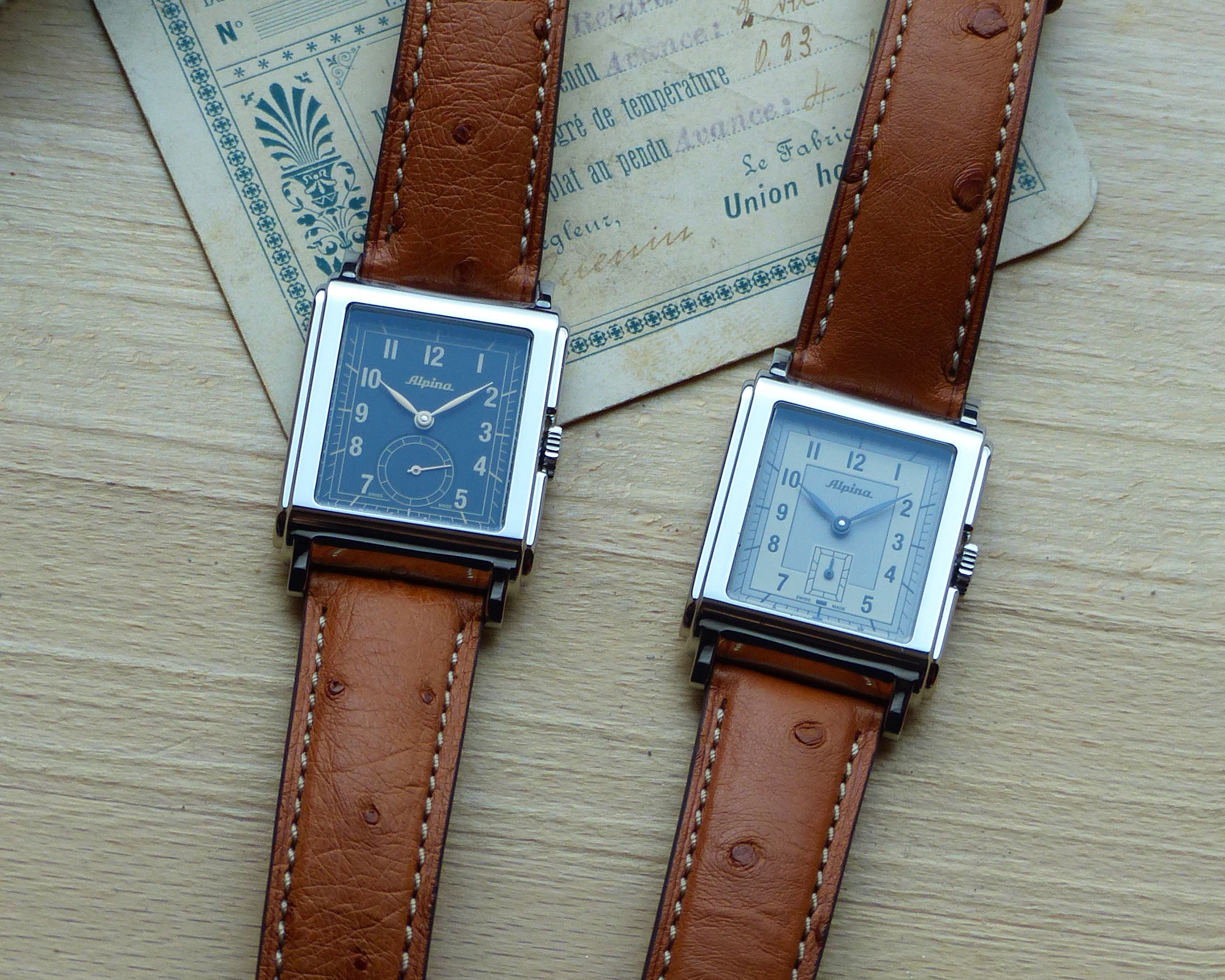
The two versions of the Alpina Heritage Carrée Mechanical 140 Years
But what makes Alpina the brand it is today, and how is this reflected in the anniversary models? In the following article, we will take a closer look at the development of the company and the new timepieces. We spoke about the brand’s past and future with Alpina’s Brand Manager, Oliver van Lanschot Hubrecht, who we met for an interview in Zermatt.
The mountains as a muse
With their breathtaking backdrop and wild, rugged nature, the mountains are both challenging and fascinating. In the case of Alpina, this combination served as the inspiration for the brand’s foundation. 140 years ago, in 1883, alpinist Gottlieb Hauser founded a watchmaking cooperative in Winterthur along with fellow mountaineers. It was based on the concept of a mountaineering society and bore the name “Alpina Union Horlogère S.A.” (“Swiss Watchmakers’ Cooperative”) at the time. The cooperative consisted of a network of specialised suppliers of watch components around Biel, including the watch movement supplier J. Straub & Co., and cooperative workshops that carried out the établissage (Fr. assembly) of the individual components. The aim was to produce robust watches that could withstand the extreme terrain of the mountains.
The fact that the mountains are an integral part of Alpina’s DNA is not only evident in the watch models. After successfully presenting their first in-house movements at the first world exhibition in Paris in 1900, Alpina became a registered trademark for the movements developed by cooperative member Jacob Straub in the following year. These movements showcased a forerunner of the logo, in which a triangle encloses a circle. The triangle represented a stylised form of the Matterhorn. A few years later, in 1908, “Alpina” became a registered trademark for watches, and the logo developed into a red triangle, the “Alpiner”, which is still their emblem today.

Earth, water, air
Alpina’s history is also linked to the military, a well-known driver of new watch models. In 1912, Alpina launched its first chronometers based on the Saxon model. A year later, the German navy used these models. In the 1920s, Alpina equipped various air forces with pilot watches. Thus, Alpina developed watches not only for the mountain world (Alpiner), but also for other terrains. Even today, these watches can be found in the Seastrong (water) and Startimer (air) collections.
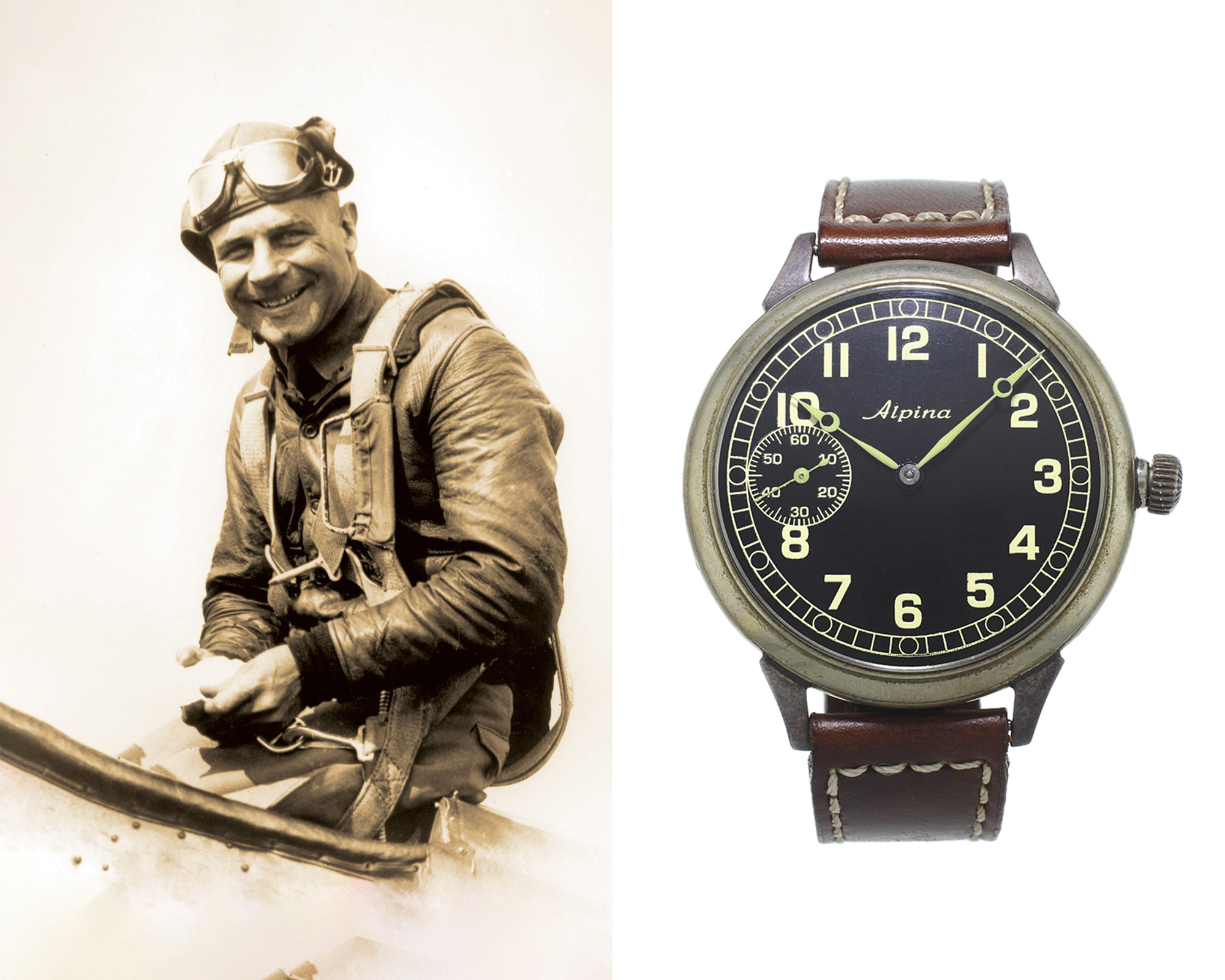
Alpina military watch around 1921
Decades of pioneering spirit
In the first half of the 20th century, Alpina was at the forefront of innovations that are now taken for granted. Given the rapid international distribution of Alpina watches, the company was one of the first to introduce an international guarantee in 1926. A few years later, in 1933, Alpina launched the Block watch, a sports watch that can be considered the original shape of sports watches as we know them today. This timepiece had a patented crown that was dust-free and airtight, thus protecting the sensitive movement.
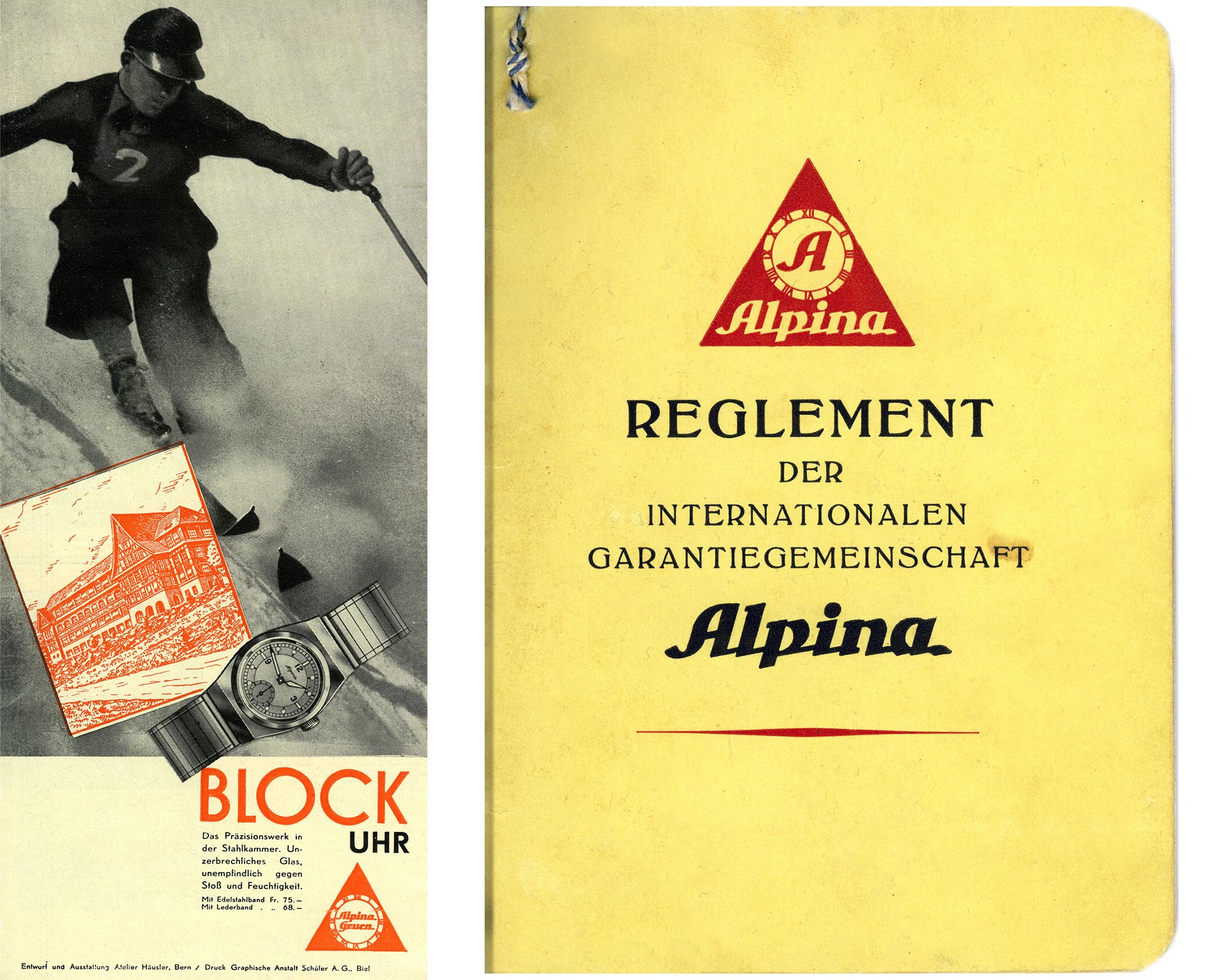
Alpinas worldwide warranty around 1926
In 1938, the Alpina 4 appeared, which stood out because of its marketing based on four features. These features included the watch being waterproof, shockproof, anti-magnetic, and rustproof. In the late 1960s, these features were expanded to ten in the Alpina 10. As journalist Lorenzo Maillard notes at the Heritage Carrée Mechanical 140 Years presentation, “Alpina was not the only brand talking about sports watches. But they were one of the first pioneers to make them more appealing to the mass market and had a strong storytelling for it.”
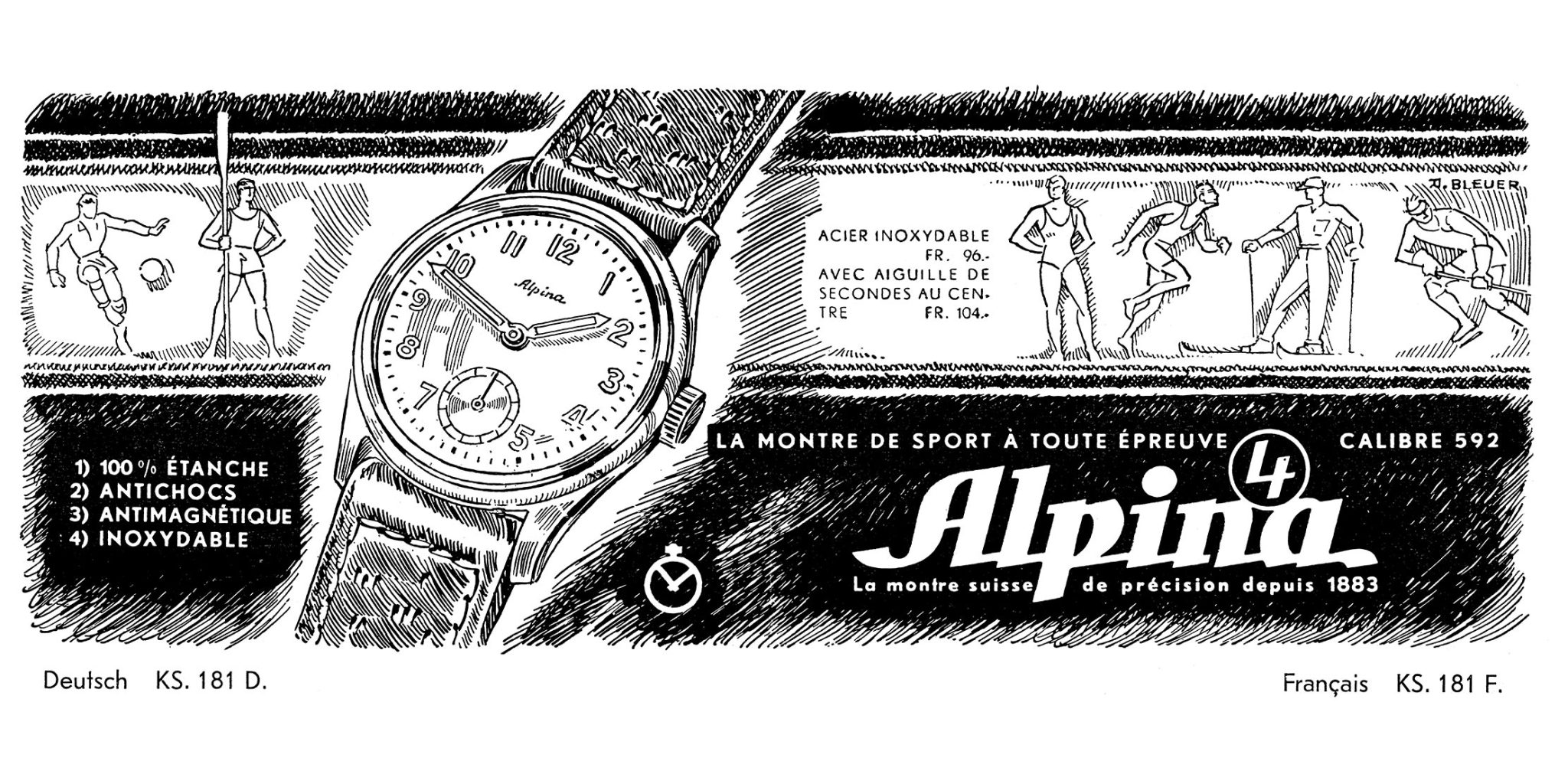
Advertising poster for the Alpina 4 around 1938
Due to the war, the 1940s brought forth many technical innovations and improved production techniques, making it possible to produce watches in larger quantities. Therefore, it was particularly important to assert oneself against the large competition through good marketing. Thus, in the 1940s, Alpina organised an annual congress where – similar to today’s press events – retailers, journalists, and collectors were invited. For Alpina’s 60th anniversary in 1943, 2000 guests attended. Here, too, the “Alpina family” concept expressed the mountaineering mentality and close ties among each other.
Towards the end of the 1940s, Alpina launched its first automatic movement and a chronograph version of the Alpina 4. In the 1960s, the brand presented its diver’s watch and ladies’ watch for the first time.
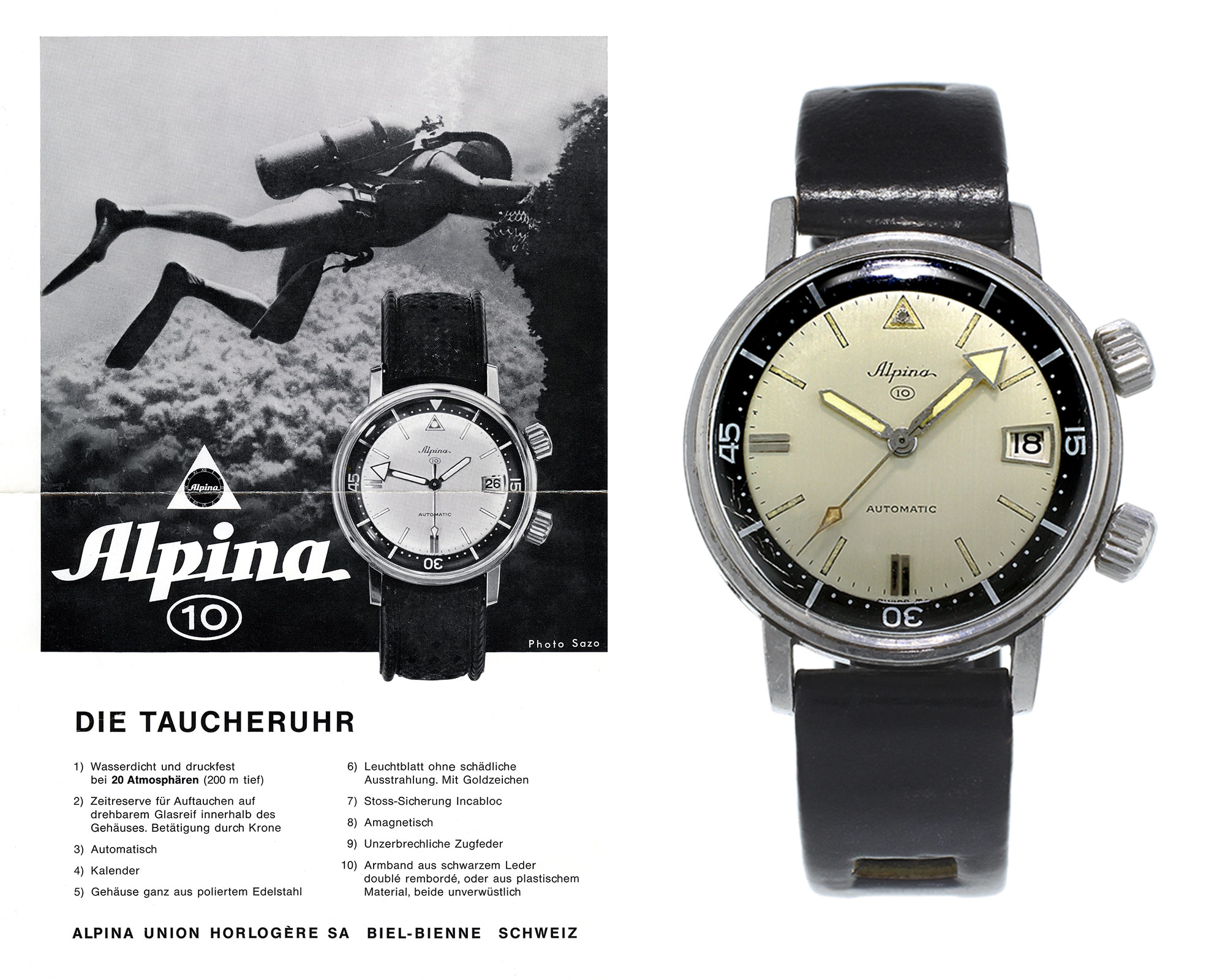
Advertising poster from the 1960s for the first Alpina diving watch Seastrong 10
Change and rebirth
With the quartz crisis, watch manufacturers were faced with the question of keeping up with change or sticking with tradition. Alpina chose the latter and had to accept some losses. This led to the brand becoming almost non-existent or, more precisely, inactive from the early 1980s until 2000. Eventually, Frederique Constant’s owners, Aletta and Peter Stas, bought the Alpina brand.
In 2003, the rebirth of the brand was officially heralded at Baselworld. The following years saw the establishment of the company’s own production facilities near Geneva and the (re-)launch of numerous models. These include, for example, the Alpiner 4 from 2014, the limited edition Startimer Pilot Heritage from 2015, and the Alpiner Avalanche Extreme Regulator, which was first released in 2005 and was presented as a new limited edition with an atypical regulator at the Watches and Wonders fair in Geneva just this year.
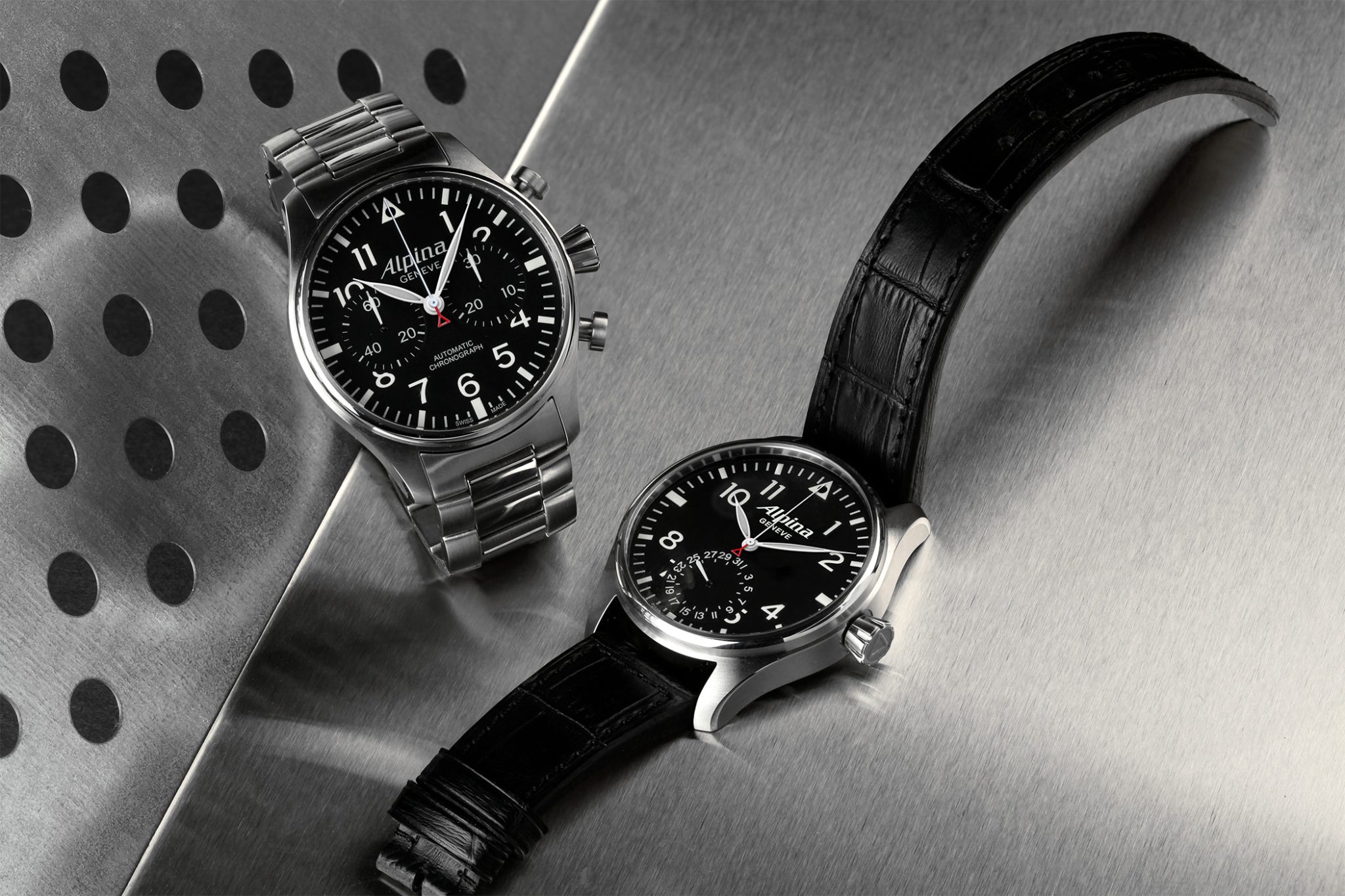
Two versions of the Alpina Startimer Chronograph, 2011
A retrospective look into the future with Oliver van Lanschot Hubrecht
High up in the mountain village of Zermatt, we spoke with Alpina’s Brand Manager about the brand’s special features, its history to date, and plans for the future.
In your opinion, what makes Alpina and its watches unique?
First of all, the heritage that we have. The original intention of the brand was to create beautiful watches that could resist the harshness of the Alps. Additionally, they wanted to bring different actors of the watchmaking industry together to be stronger and offer affordable and beautiful watches with a strong DNA. I think today we have all of that together – especially with the new Extreme watches that we reintroduced in 2022 after their original launch in 2005. The idea is to breathe the Alps, but also see the history behind it, when you look at your watch. I think we really have a beautiful, strong sports watch with a distinctive design and a strong Alpina DNA. But still at an affordable price: the brand’s average price is 1,500 euros.
What are the distinctive features of an Alpina watch? Also, in relation to the four – or actually ten – characteristics.
In terms of features like water resistance, I think, they can be provided by any brand today. So, we’re not really focusing on those features. Today is about offering a really high value product but still at an affordable price with a strong recognition and DNA to it. For example, with the Alpiner Extreme line, we’ve got a four-part case construction. I think you will not find that level of finishing we have with the case and the bracelet on the market today if you look at the competitive environment. When someone looks at our watches, we would like them to recognise where we come from.
In 2023 you introduced a new Alpiner Extreme with a regulator indication. What was the reason behind this?
The regulator was actually the iconic movement that we had in the Avalanche Extreme that we launched in 2005, which was hand-wound at that time. However, that was a much larger watch with a 48 mm case. This model was iconic for the brand at that time, so for that reason, we chose to revive this model, which is quite rare as regulators are not very common today, especially in a sports case. But we thought that as a tribute to this successful watch that we had back then, we could come back with a regulator and a limited edition. We have three limited editions or 888 pieces, and we’ve been very successful with them. They sell just as well as a three-hand automatic, which is pretty amazing.
What is your best-selling watch or collection?
It’s the Alpiner Extreme for sure. We only launched it in 2022 but it’s already a bestseller. Most of our references are really, let’s say, in the top 5 to 10 watches that we’re selling very quickly. We could actually not even keep up with production. So, we underestimated the success that we were going to have with the product a little bit. Now we’re back on track. But we had a little dip, where we couldn’t replenish the stores, which is a nice problem to have, of course. It shows the success of the design and of the watch.
What would you say has changed significantly since the brand was taken over by Frederique Constant?
The brand was taken over in 2002, so it’s been 21 years now already. When the brand was taken over, the price point was higher. We actually had a special case to answer for back then. Ever since, Alpina has been trying to find its way. We got acquired by the Citizen Group back in 2016. So then came some more affordable products. Then we released some innovations with smart technology. That was great for the brand because it gave us visibility. However, we decided to go back and fully concentrate on mechanical, traditional Swiss made watches with the Extreme design in focus now. Back to the roots again. I think the people recognise that it’s the right way to go.
What are the advantages of being part of a group?
The opportunity that we have is that we can still function pretty much independently within this group in terms of development, strategy, product development and so on. But we can also benefit from the group. It gives us strength and potential as well as the other companies of the group, who produce movements for example. We can benefit from that as well. Now we are finally getting there – to benefit from the affiliates and the distribution potential they can develop for us.
What are Alpina’s strongest markets?
We’re available in over 50 countries now but Western Europe and the US are the leading markets that we’re looking to develop further first. Speaking of Western Europe, France is actually our biggest market. We’ve got over 100 points of sales there. So, we’re quite established over there already.
How would you describe the typical Alpina customer?
It’s somebody who works in an urban environment but aspires to go outdoors, to go skiing, diving, or sailing. Maybe today the customer would be, let’s say in a broader age range, between 30 and 50 years old. I would say that through our ambassadors, the sports, and activities, we are targeting younger customers, of course, to appeal to the younger generation, so that they potentially buy their first serious watch.
Are you planning on creating or building up mono-brand boutiques?
No, that’s not part of our strategy right now. We’re developing distribution. We’re opening and looking at multi-brand environments. You can see a trend in the industry with brands that are leaving multi-brand environments and opening boutiques. You can also see a trend for some competitors to increase prices and leave this space between 1,200 and 2,000 euros or even 3,000 euros. For us, this is really an opportunity to take that space in multi-brand retail environments.
What about e-commerce? Does it work for brands like Alpina who might need a little more introduction?
Yes, of course. I mean, e-commerce helps the availability of the watch – while we’re very established in some markets and in some others less established, we’re progressing quite fast. So, of course, e-commerce fills the gap. In terms of availability, we’ve also developed in the digital space. We’ve done quite a few campaigns and communicate that way. We’ve built a large community of online Alpinists and that helps in terms of reach, communication, and sales – whether we do it ourselves or via third party partners.
What is your strategy for the future? How do you want to help make the brand succeed and move even more progressively towards the future?
There are three things. I think currently, product-, strategy-, and collection wise, we’re very good. So, we really want to focus on establishing the Alpiner Extreme as the recognizable Alpina product, even though we’re going to continue to develop watches in other universes. Then, there’s the distribution that we have to develop further. Again, we’re looking at doubling or tripling our availability in points of sale within the next three years.
Finally, in terms of recognition and awareness, we want to speak much more about our heritage, where we come from. We have this rich history that needs to be communicated because not enough people know about it. We want to show that and give credibility and legitimacy to the brand. But from a product perspective, keeping this price point, let’s say around 1,500 euros, on average, up to 3,000 euros, not going up in price too fast. Maybe at a later stage, when there are in-house movements again, but for now we have established the brand in this segment.
Alpina once gained a reputation for its production of in-house calibres. At the moment, however, the in-house calibres represent just a small portion. Are you planning on further evolving the production of in-house movements again?
Yes, but at a later stage. Of course, the movements that are developed, produced, and assembled in-house have a higher price point. At this stage, we don’t want to go up in price too fast. That doesn’t prevent us from maybe doing an edition or one watch that has this. We can see this with the very limited 490. It’s actually in-house – but from 85 years ago. So, we have one in the collection at the moment. But for new developments, we don’t want to move too fast. We really want to establish this price point and not go over 3,000 euros. With manufacture movements we’ll reach the 4,000 or 5,000 euros mark quite quickly, which is not the right time for us yet. But you can expect it to come at a later stage.

Alpina Manufacture, 2006
How many watches does Alpina produce each year?
We don’t communicate exact numbers. But what I can say is that the brand is doing well, recovering from the crisis gloriously as orders are going through the roof, with an increase in the average price. We are aiming at developing our number of points of sale, especially in the key markets – and Germany is part of that plan. So, you can expect to see a lot more from Alpina.
Breaking new ground
In 2015, Alpina came up with a first in the Swiss luxury sports watch industry. The Horological Smartwatchrepresented the first Swiss Made Connected watch with an analogue dial that is connected to the smartphone. But in addition to exploring a new generation of watches, Alpina has also been concerned with environmental issues in recent years. Besides environmental initiatives, the watch brand produced two models made from recycled materials. The Seastrong Diver Gyre Automatic from 2020 has a case, bracelet and box made of recycled plastic from the oceans. Two years later, Alpina released the Seastrong Diver 300 Automatic Calandawith a case made of recycled steel.
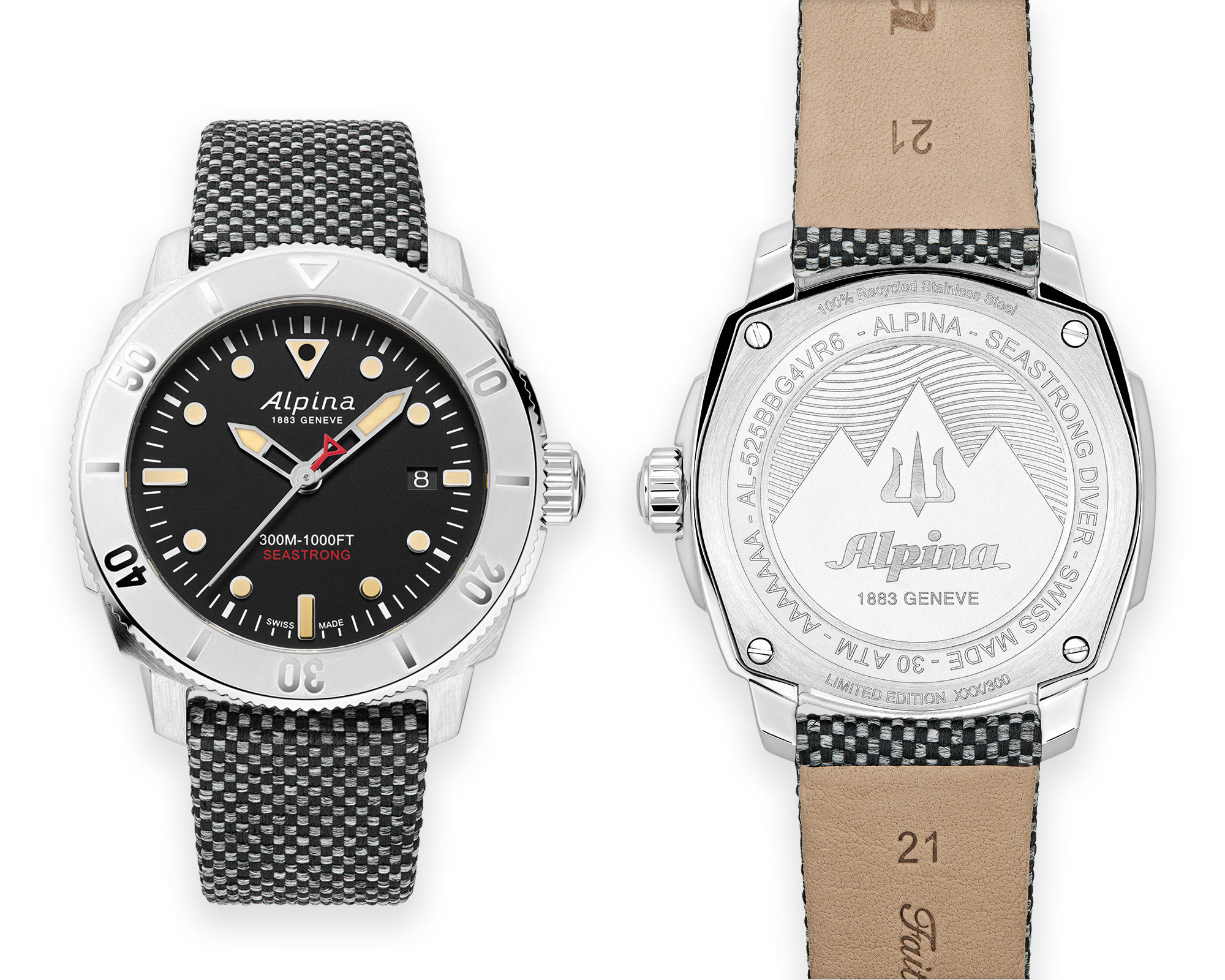
Alpina Seastrong Diver 300 Automatic Calanda, 2022
In the past you’ve also shown commitment with regards to sustainability. Is there a clear sustainability strategy or something more planned for the future?
Absolutely. Right now, we’re working very hard on this strategy at a company level. You may have seen in the past with our Shape the Change initiatives that we have developed some watches using recycled materials. Now we’re working on a long-term plan, a ten-year plan, which is completely focused on how we behave as a company. So, now we’re working strongly on building this agenda with strong commitments, objectives, and targets, which we will communicate at a later stage. Hopefully this year we’ll have that plan in place that we can then roll out. Especially since this is our playground – the mountains, the sea… Even if watches don’t have the biggest carbon footprint because they stay with us for a long time, there’s still a lot we can do – as a brand and as a person.
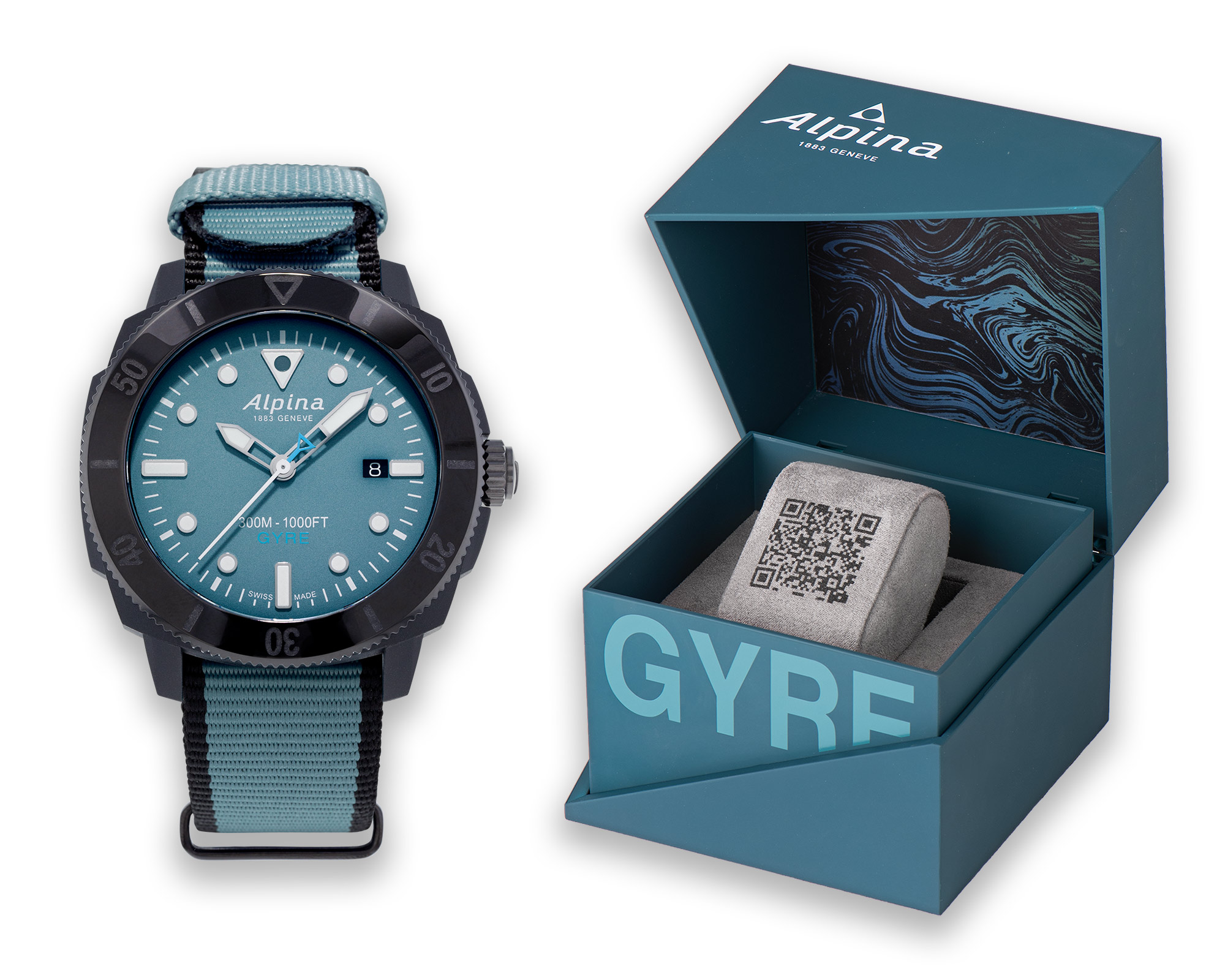
Alpina Seastrong Diver Gyre Automatic and Recycled Plastic Presentation Box, 2020
Was there a noticeable interest in the Seastrong Diver Automatic, particularly because it was made from recycled materials?
Yes, it depends on the markets that have, let’s say, a higher watchmaking, education, and understanding. I think especially the younger generations are able to wear watches that consist of recycled materials. The environmental awareness is there. So, we saw a great interest. Of course, it also comes at a price. It’s simply more expensive to create a recycled material: collecting fish nets, grinding them into pellets and then remelting them and creating a material that’s tough enough to resist in a diver’s watch. We see that not everybody is ready to pay more for a watch with a recycled case. Some people, yes, but not everyone. So, we’re not there yet.
The quartz crisis almost destroyed the brand. Today, you also offer smartwatches and more modern watches. If we look back, Alpina actually wanted to stick with mechanical watches back then. What is the key nowadays to finding the balance between modernity and tradition without losing your own identity?
I think the smartwatch is a great example for the Alpina’s innovative side. In 2015, no other brand managed to make a Swiss made smartwatch, that was beautiful to look at but included smart technology. So, we gave it a try. Then we also realised that there were limits to it, and we decided to fully refocus on mechanical watches. So, it’s important to know that we need to try to seize opportunities to develop, to continue to be creative to further evolve, but not forget where we come from and what our DNA is.
Which are the most sought-after vintage Alpina timepieces for collectors?
There are many special watches out there. For example, cases that were almost uniquely made by craftsmen at the time. So, you can find real gems. I cannot really put my finger on a specific one. But I would say that some of the original Seastrong models, the Alpina 10, the original super compressor models and some with original “bumper movements “ are really interesting. Not to forget about the beautiful pocket watches from the early days of Alpina. So, I can’t settle on one.
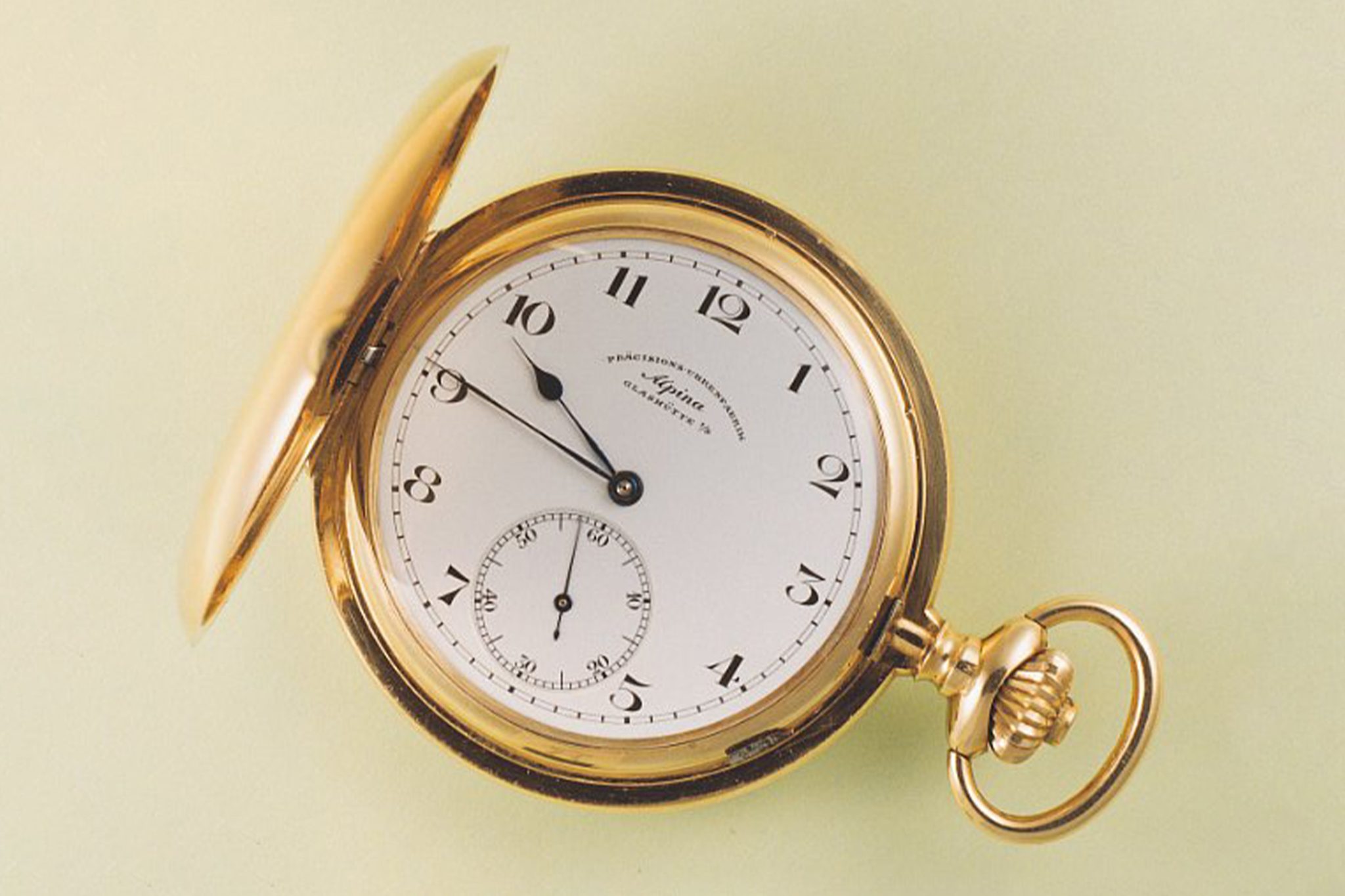
Alpina Chronometer, 1912
This year, Alpina is again revolving around the theme of recycling – but in a different way than before. To mark its anniversary, Alpina launched the Alpiner Heritage Carrée Mechanical 140 Years with an original calibre from 1938. Let’s take a closer look at the two versions of the limited-edition timepiece.
What a coincidence: The development of the Alpiner Heritage Carrée Mechanical 140 Years
Some things are forgotten, only to reappear at the right time. This is what happened to the movement of theAlpiner Heritage Carrée Mechanical 140 Years. As chance would have it, a phone call reunited the calibre AL-490 with its manufacturer. Alpiner’s Brand Manager Oliver van Lanschot Hubrecht recounts:
“About three years ago, I was contacted by somebody who said he had found original 490 movements at a retailer who had a service centre in Switzerland that was closing their business. So, he gave me a call and he said, ‘The movements are perfect. Would you be interested in this?’ I said, ‘Sure, send me one. Let me check it out.’ Not being quite sure of what I was going to receive. But I received a beautiful little movement packed in its original wrapping paper. Wow! I had it checked by a watchmaker who said, ‘The movements are new, they’re fully unused.’ Of course, I bought the lot and I said that this was something we should do something really special for. There was no better occasion than to use this for the 140th anniversary and integrate it into a new watch.”
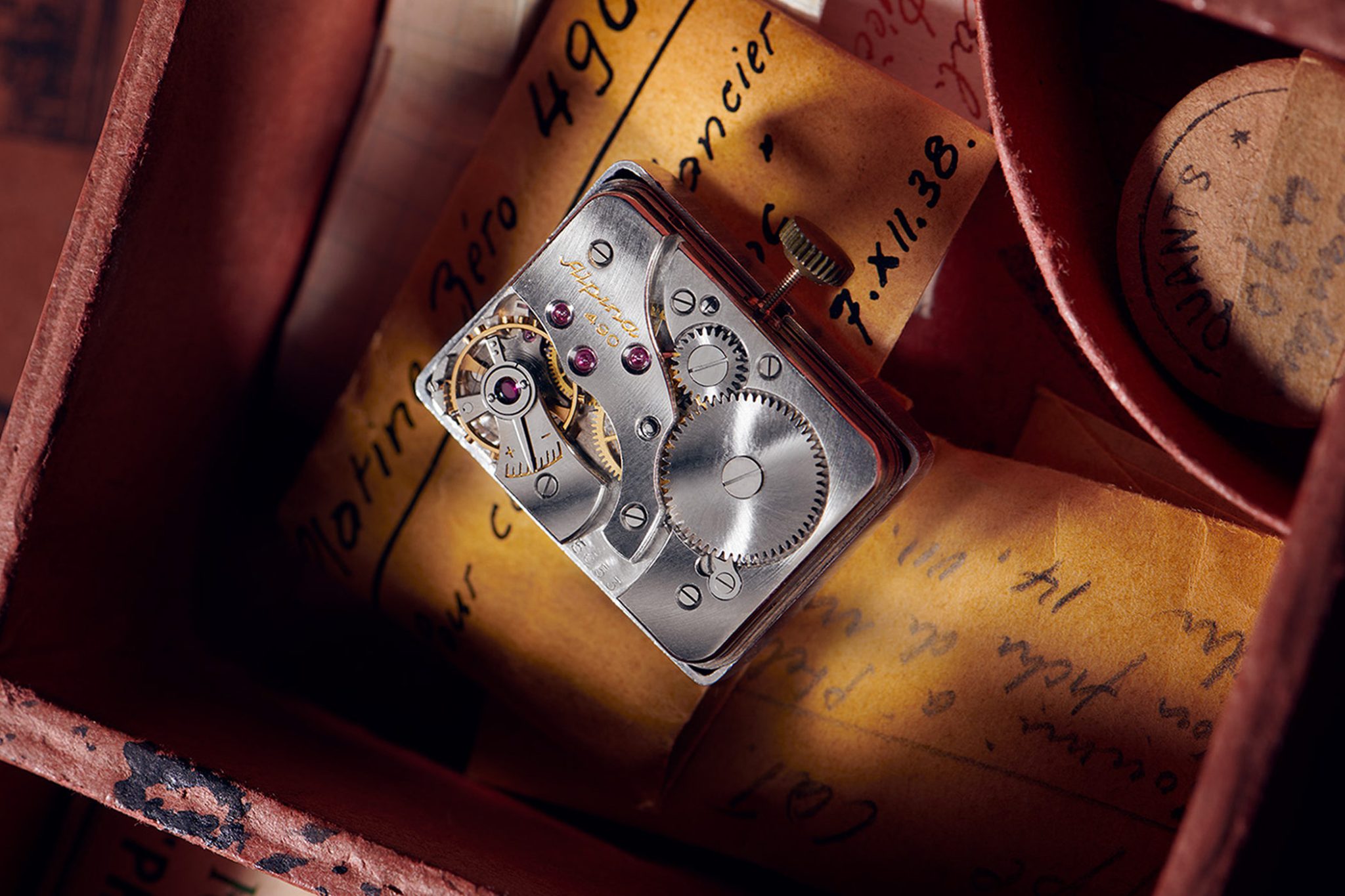
Alpina Caliber AL-490
There could hardly be a better way to celebrate a jubilee than with an anniversary model that literally contains a piece of history. In this case, it was the AL-490 calibre, which was registered as a patent under the number 158882. It is the hand-wound centrepiece of the two micro-series of the Alpiner Heritage Carrée Mechanical 140 Years, each limited to 14 pieces. The calibre itself was developed by a company of the Alpina Group for Alpina as early as 1921. However, it did not come onto the market until 1938 and, according to Maillard, its production was probably discontinued due to the rise of automatic movements.
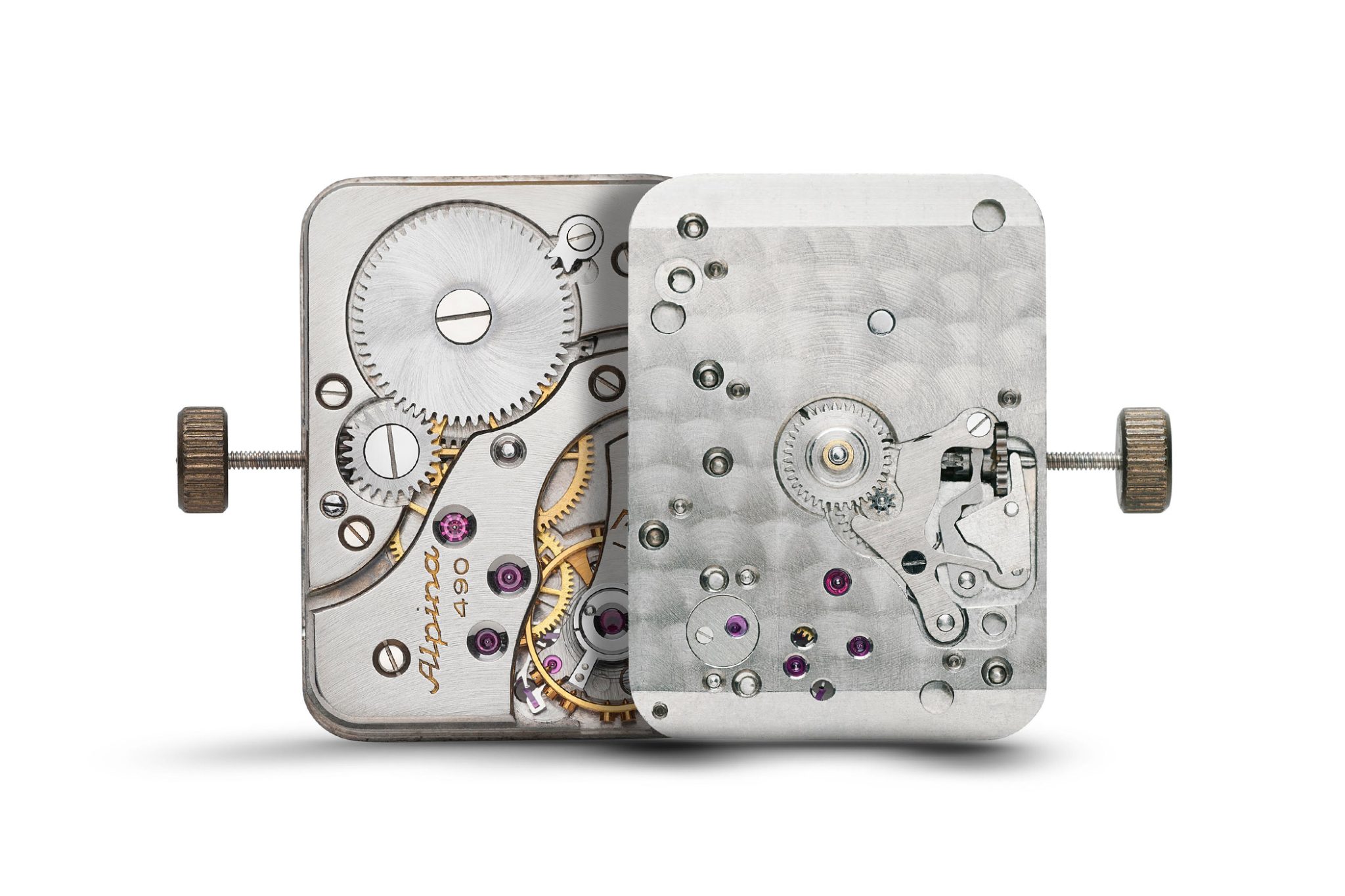
The movement is characterised by its unusual rectangular shape and, therefore, unusually elongated lever. This is because the calibres that were used in a square case were usually round. Aside from Alpina, Omega and Longines also produced such angular movements. The AL-490 calibre operates at a frequency of 2.5 Hz and has three bridges with bevelled edges, a sunburst ratchet wheel and a patented crown with dust protection. The power reserve was 42 hours and special for that time.
At the time, the movement was used in various cases, including a patented stainless-steel case and a gold case with two seals to protect it from water. The dials also varied, but – typical of the 1930s – there was always a sub-dial at 6 o’clock and radium hands for improved visibility. Today, the restored movements have found a new home in a mirror polished rectangular silver case with an open caseback made of anti-reflective sapphire crystal. This measures 29.5 x 35.7 mm.
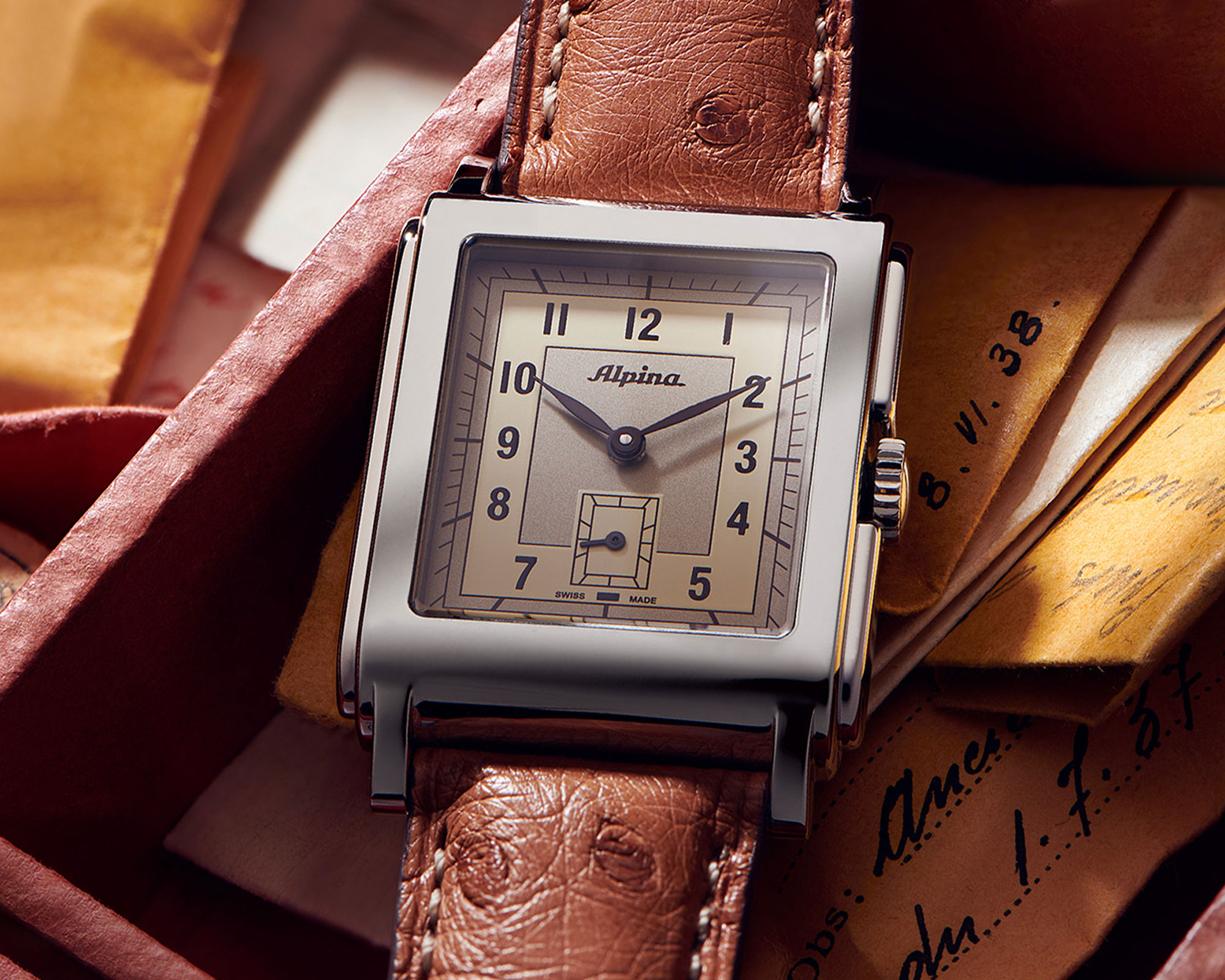
Alpina Heritage Carrée Mechanical 140 Years with silver dial
Despite having the same case, the two versions of the Alpiner Heritage Carrée Mechanical 140 Years differ in their dial’s finish. The model in one series has a black designed dial, while the other has a silver-coloured dial with a cream-coloured minute ring. The black dial has beige Arabic numerals with a circular small seconds. The silver dial, on the other hand, is adorned with black Arabic numerals in an upright font and a square small seconds. A so-called Chemin de fer minuterie, railway minuterie, surrounds both dials. In addition, both versions bear the Alpina logo of the 1930s and have two narrow central hands, in beige for the black version and in black for the silver version.

Alpina Heritage Carrée Mechanical 140 Years with Black Dial
The silver and black versions have a light brown ostrich leather strap with white vintage stitches and a pin buckle. Both versions are available for the price of 4,995 euros and come in a specially designed engraved box.
Are there some more fun facts about the models themselves or even tracking the calibers? Or was it, as you said, just pure coincidence that someone contacted you and said, ‘I just found that treasure’?
I get contacted regularly by people who find vintage Alpina watches or movements. It is quite exciting to have the chance to work on such projects with all the research aspects, and to discover marvels from our heritage. However, having the opportunity to find a large number of the same movement that are in such good condition doesn’t happen every day. So, we were hugely lucky to have that. But maybe through this story and through your article and the coverage that we’re going to get through this event, somebody is going to pick up the phone and say, ‘I’ve got something, and I have no idea what I want to do with it, what I can do with it. Maybe you’re interested.’

